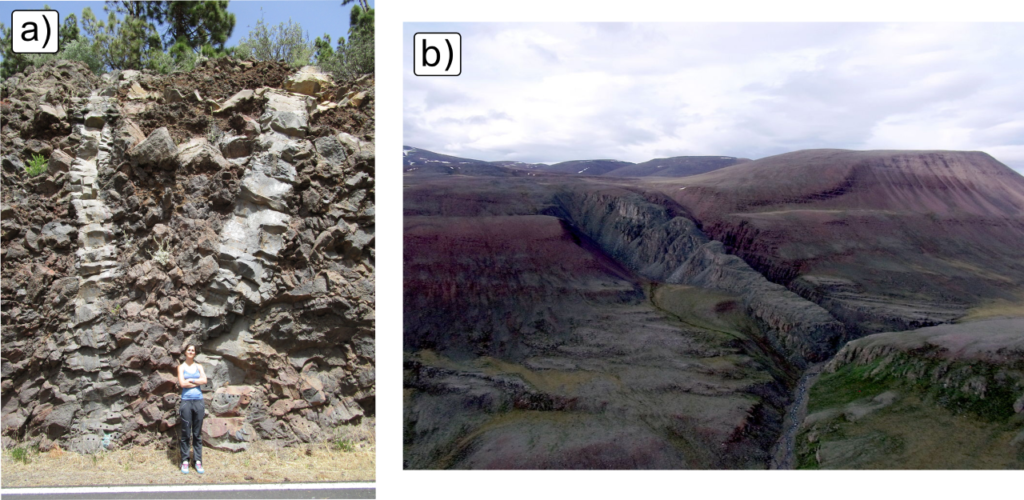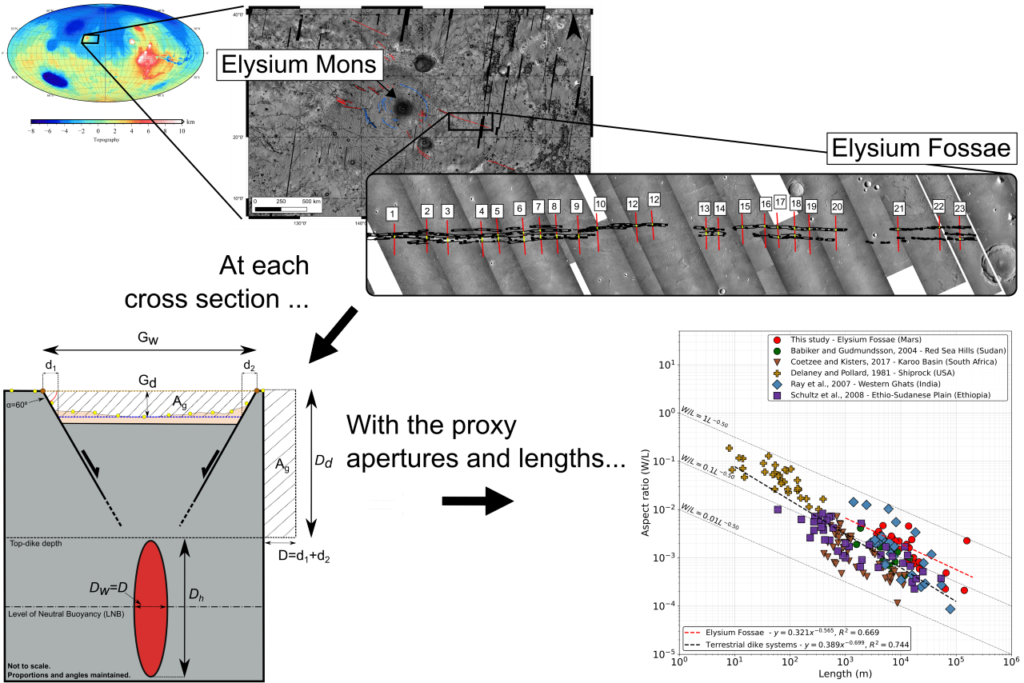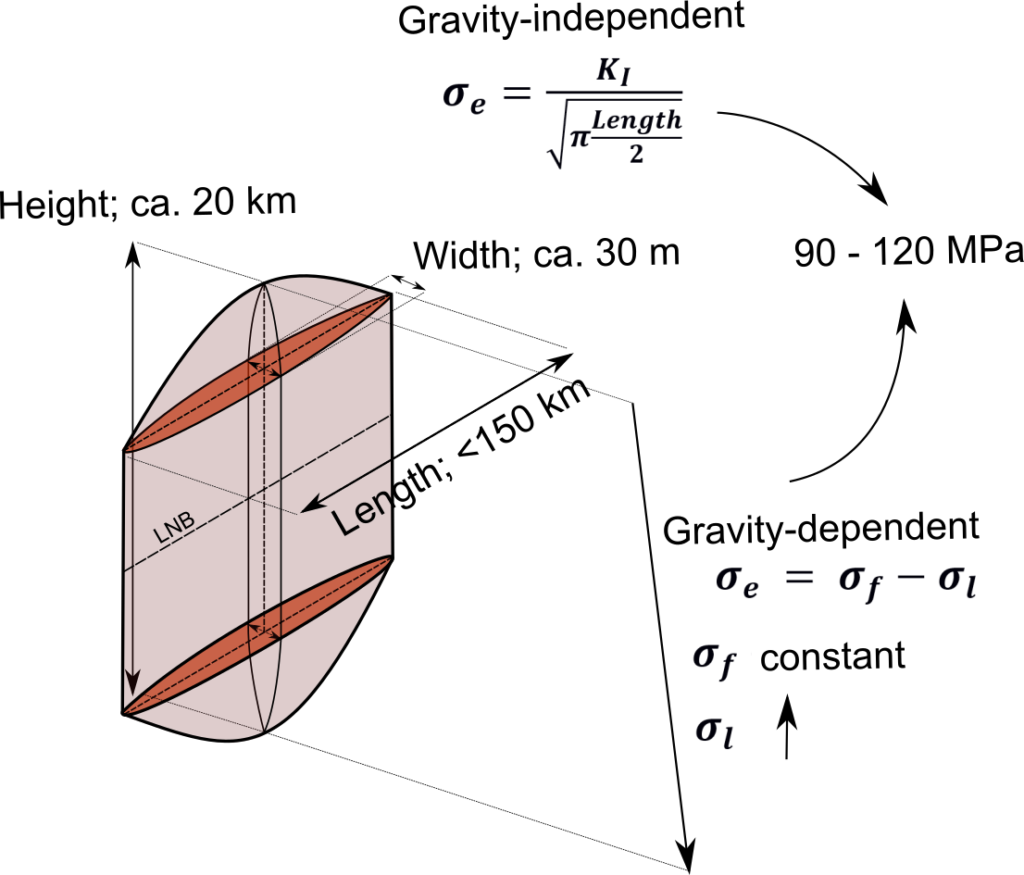
Sam Rivas-Dorado – Complutense University of Madrid
The geology that we find on Earth is but one example of what geology ‘may actually be’. The same processes, operating under the same universal laws of physics, may have very different effects on planets with different sizes, compositions, layering… Thus, to develop a full understanding of our discipline, it seems reasonable to try and approach it in a multi-planetary way. Dike intrusion is no exception to this.
On Earth, dikes associated with small volcanic edifices typically have apertures of a few meters (Figure 1a), vertical extents of 7 km on average, and lengths of up to several tens of kilometers. Dikes in dolerite swarms are however much larger, with apertures of up to several hundred meters (Figure 1b), largely unknown vertical extents and lengths of hundreds of kilometers. And so, puzzling comparisons emerge after estimating the geometry of giant dike systems on Mars. Using a classic structural geology technique, cross-section balancing, and surface topography, we approximated the subsurface geometry of a possible dike system underneath Elysium Fossae, a set of long grabens east of the Elysium Mons volcano, Mars (Figure 2), with surprising results.

Figure 1. a) Meters-thick Tertiary dikes in a road outcrop west of Mount Teide, Tenerife, Spain. b) One of the Proterozoic dolerite dikes of the Franklin swarm in the northwest of Baffin Island, Canada. The scale is unclear, but it is likely safe to assume that the riverbed is a few meters width, and therefore that the dike is several tens of meters thick. Image Source: Wikipedia
Cross-section balancing was first used in the early 1910’s by R.T. Chamberlin to estimate the detachment depth of the folds in the Appalachian Valley and Ridge fold-and-thrust belt of central Pennsylvania. This method has since been adopted and improved by structural geologists in both academia and industry, and even today we are still finding new applications for it.
In the case of Martian magmatic intrusions, cross-section balancing has allowed us to obtain proxy values for the aperture and depth of the possible dikes beneath Elysium Fossae (Figure 2). A key parameter obtained is aperture, which results from the cumulative heave of the graben-bounding faults. Similarly to the dolerite swarms, the average aperture inferred for the Elysium dikes is 30 m. They are also buried between 200 m and 2000 m below the surface and are assumed to have lengths equal to the graben they produced at surface, up to 150 km. Additionally, the inferred aspect ratios are consistent with fluid-induced fractures, further supporting the initial assumption that these graben host dikes at depth (Figure 2).

Figure 2. Location of the Elysium Fossae graben in the context of the Elysium Rise. The topographic profiles used are indicated. A conceptual sketch of area-balance is shown, with the key parameters obtained in italics (Dw = Dike aperture, Dd = Dike depth). Finally, the chart in the bottom-right demonstrates the aspect ratio (length vs aperture) of the Elysium dikes compared with other dike datasets.
From here we delve into further speculation. Through previous estimations of the Martian Level of Neutral Buoyancy and assuming that the dikes propagated 1) laterally at this level, and 2) vertically upward and downwards from it, a possible average vertical extent of these dikes is in the vicinity of 19 km. Interestingly, the height of dikes on Mars and Earth is related by the same ratio as their gravitational acceleration, at about 1/3.
Using the results of cross-section balancing as a proxy for dike geometry bears significant uncertainties. One sanity-check of the geometries obtained is that the aperture-length scaling relationships are consistent with fluid-induced fractures, which would be expected for a dike. Another way to test the validity of the geometries obtained, and at the same time investigate the possible scaling of height with gravity, is calculating the dikes’ excess pressures. One gravity-independent calculation of excess pressure comes from the so-called stress intensity factor (KI) which is calculated from the dike’s aspect ratio and the host rock mechanical properties.

Figure 3. Dike sketch showing the approximate dimensions of the Elysium dikes. The gravity-independent and gravity-dependent calculations converge at similar, albeit large, excess pressures for dikes of the inferred geometry.
Another, gravity-dependent, calculation of excess pressures is derived from assuming a fixed fluid pressure within the dike given by its height (σf). In this case, the excess pressure (σe) along the vertical extent of the dike is obtained as the difference between the increasing lithostatic stress (σl) with depth and dike pressure (Figure 3). For these latter calculations, Martian conditions must be considered, i.e., a gravitational acceleration of 3.7 m s-2. Interestingly, both gravity-independent, and gravity-dependent estimates using 19 km dikes yield consistent excess pressures, around 100 MPa. Although these are very large values, the convergence of the results suggests that the inferred dimensions of the dikes are somewhat sensible.
It therefore seems reasonable to conclude that the geometries obtained here are consistent. Elysium Fossae is likely to host dikes which are tens of meters thick, comparable to those in dolerite dike swarms, and very tall, with vertical extents close to 20 km. Not only this, but it is also within the realm of possibility that the height of dikes is somewhat dependent on a planet’s gravitational acceleration. Therefore… what is the geometry of dikes in Mercury? What may have been the true size of the ancient dikes in the great terrestrial swarms? Only through answering these questions, amongst others, will we begin to truly understand these intrusions, past or present… on Earth, or beyond.

Sam is a structural geologist with more than 6 years of experience in the oil and gas industry, and has recently moved from being a part-time to a full-time Ph.D candidate at the Complutense University, Madrid.
In his time in the industry, Sam dealt with 2D cross-section restorations, fault and fracture characterisation, deformation modeling, as well as applying his research to find new methods to estimate detachment depths in contractional syn-tectonic sequences.
In his thesis he uses classic techniques and numerical modelling to investigate the processes around giant dikes and dike-induced graben, from emplacement conditions and host-rock properties to dike-induced seismicity, in the subsurface of the Elysium Rise region, Mars.
You can read more on Sam’s latest research findings in this recent publication: Rivas‐Dorado, S., Ruiz, J. and Romeo, I. (2021), Subsurface Geometry and Emplacement Conditions of a Giant Dike System in Elysium Fossae, Mars, Journal of Geophysical Research: Planets, 126(1), p.e2020JE006512.
Get in contact with Sam at samuelrivas@ucm.es, and connect via Twitter @geognostsam or LinkedIn.
Would you like to be featured on our blog?
We’re on the hunt for fellow VIPS enthusiasts to share their stories, whether you’re a student, an early career researcher (ECR) or more experienced researcher – we want to hear from you!
Do you have a new paper to tell the world about? Or have you been involved in some exciting fieldwork recently? Get in touch at info@vipscommission.org to tell us what’s going on in your field of VIPS.

 Igneous Intrusions Emplaced into Organic-Rich Shales
Igneous Intrusions Emplaced into Organic-Rich Shales
Leave a Reply